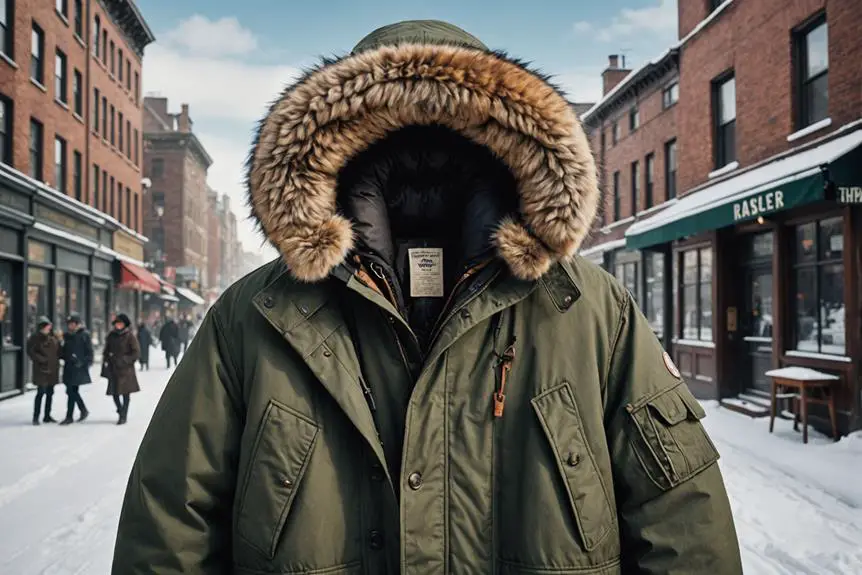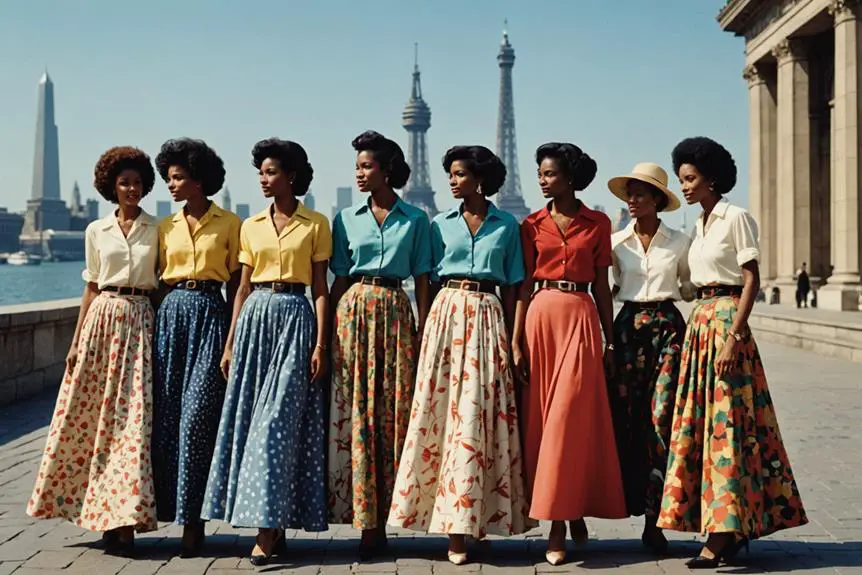When you think of the classic fishtail parka, you might picture British mods strutting down the streets in the 1960s, but its journey starts much earlier among the Inuit and Indigenous peoples of Canada. You might be surprised to learn how this practical garment transformed from Arctic survival gear to a symbol of counterculture and fashion. The parka's evolution reflects broader societal changes and innovations, raising questions about its significance today. What does this mean for the parka's role in modern wardrobes?
Origins of the Parka

The origins of the parka reveal a rich tapestry of cultural adaptation and survival. You might be intrigued to learn that the word "parka" stems from the Nenets language, meaning "animal skin." Historically, this garment was crafted by the Inuit and other Indigenous peoples in Canada, designed specifically to offer warmth and protection against the unforgiving cold of the Arctic. Early parkas made from caribou or seal skin featured the fur side facing outward, providing insulation while being treated with fish oil for waterproofing.
These ingenious designs not only kept wearers warm but also showcased the deep connection between the people and their environment, as they utilized available resources to meet their needs. Among the most fascinating variations is the amauti, which includes a built-in baby pouch. This clever addition maximized warmth through the mother's body heat, allowing for both comfort and maternal care in the harsh climate.
The historical significance of the parka can't be overstated, with its first documented usage in English literature dating back to the late 18th century. This garment represents not just a practical solution to extreme weather, but also a symbol of resilience and ingenuity that has evolved over generations. As you explore the history of the parka, you can appreciate how it embodies both the traditional practices of Indigenous cultures and the continuous adaptation to the challenges posed by nature.
Military Adoption and Innovation
During World War II, the U.S. military recognized the necessity of equipping pilots and soldiers with parkas that could withstand frigid conditions while accommodating their bulky uniforms. This marked the beginning of a remarkable evolution in military outerwear, similar to how Carhartt evolved its product lines to meet the needs of workers in challenging environments. The military adopted designs like the B-9 Down Parka, developed by Eddie Bauer, which seamlessly combined warmth with a lightweight feel, allowing soldiers to layer effectively. Another innovative design, the N3-B "snorkel" parka, was tailored for extreme cold, featuring a high-zip design that limited visibility but maximized warmth, vital for soldiers engaged in cold-weather warfare.
Wartime rationing played a significant role in altering parkas' construction. As resources became scarce, the military shifted from luxurious fur linings to synthetic materials, ensuring that soldiers remained warm without compromising on supply needs. This innovation not only adapted to the circumstances but also improved the durability of the parkas.
As the Korean War unfolded, the introduction of the fishtail parka, characterized by a split rear for enhanced mobility, led to the creation of iconic models like the M-48, M-51, and M-65, becoming standard issue for soldiers in the field. These military surplus parkas eventually transcended their original purpose, becoming symbols of countercultural movements in the 1960s and 70s. Their functional design and rugged appeal captured the hearts of civilians, showcasing the remarkable journey of the parka from military necessity to cultural icon.
Fishtail Parka Development
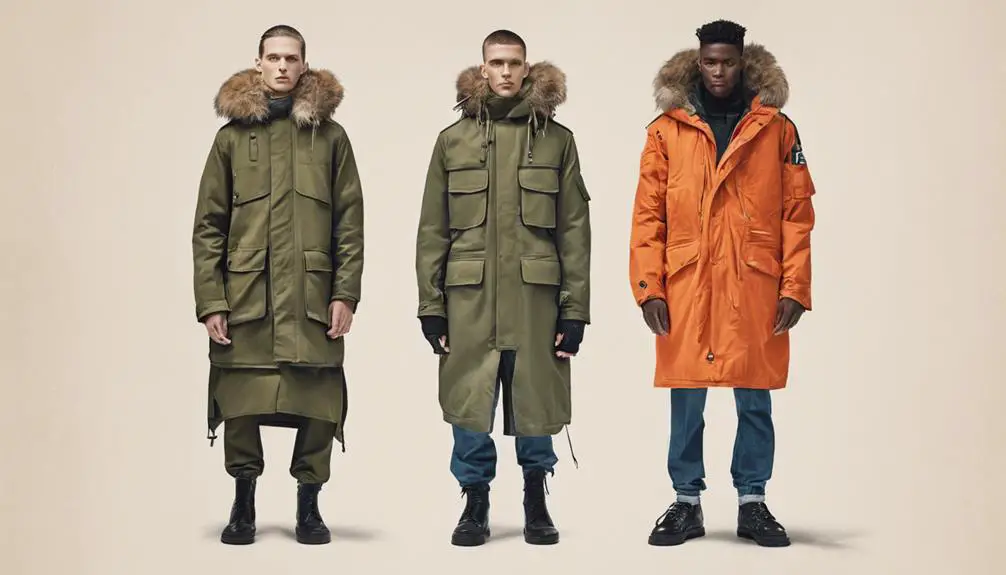
Introduced in 1951, the fishtail parka was specifically designed for U.S. Army soldiers during the Korean War, addressing the urgent need for enhanced warmth and mobility in cold weather conditions. Its innovative design featured a distinctive drawstring hem, allowing soldiers to customize the fit, which helped retain heat while providing practical functionality. Large pockets were included for easy storage of essential supplies like food and ammunition, making the fishtail parka a vital piece of military gear. The parka's durable construction and functional features were part of a broader trend in military apparel that prioritized both protection and utility, similar to the evolution seen in luxury fashion brands like Barbour, known for their high-quality outerwear vintage Barbour identification.
As the years progressed, various models like the M-48, M-51, and M-65 evolved, each iteration focusing on improved materials and insulation without sacrificing combat practicality. The emphasis on warmth and durability guaranteed that soldiers could perform effectively in harsh environments, which was essential during the challenging Korean War.
But the fishtail parka's journey didn't end in the trenches. After the war, it shifted into military surplus and quickly gained popularity among civilians, particularly within youth subcultures. Its blend of practicality and distinctive design caught the attention of fashion-forward individuals, leading to its rise as a symbol of street fashion. The parka's unique style and functional elements made it an appealing choice for those wanting to combine warmth with a trendy aesthetic.
Today, the fishtail parka remains a beloved staple, seamlessly blending its military roots with contemporary fashion, proving that practicality can indeed be stylish.
Cultural Impact in the 1960s
In the vibrant world of 1960s fashion, the fishtail parka emerged as a defining garment for the British mod subculture, perfectly blending style with functionality. This iconic piece, originally designed for military use, found new life in youth culture, becoming a symbol of rebellion. Mods embraced the loose fit of the parka, allowing them to wear it over their tailored suits, protecting their stylish attire from dirt while maintaining a polished look. The cultural impact of practical pieces like the parka can be seen in how they resonate with different demographics, similar to the appeal of modern brands like Ralph Lauren's cultural impact.
As military surplus parkas made their way into the hands of the fashion-forward, young people began customizing these pieces with patches and badges. This personal touch not only showcased individuality but also amplified the parka's popularity among the mod scene. Riding scooters through the streets of London, mods donned their stylish parkas with pride, embodying the spirit of the era.
The fishtail parka gained even more prominence during the Bank Holiday riots, where it became closely associated with youth culture and the rebellious spirit of the time. Its practicality and chic aesthetic made it a favorite among those looking to make a statement. The fishtail parka's unique blend of function and flair solidified its status as a fashionable staple, influencing trends for decades to come.
While the parka's roots can be traced back to military origins, its transformation into a mod icon illustrates the dynamic relationship between fashion, identity, and cultural movements. The legacy of the fishtail parka continues, reminding us of the power of style in shaping youth culture.
Evolution of Modern Designs
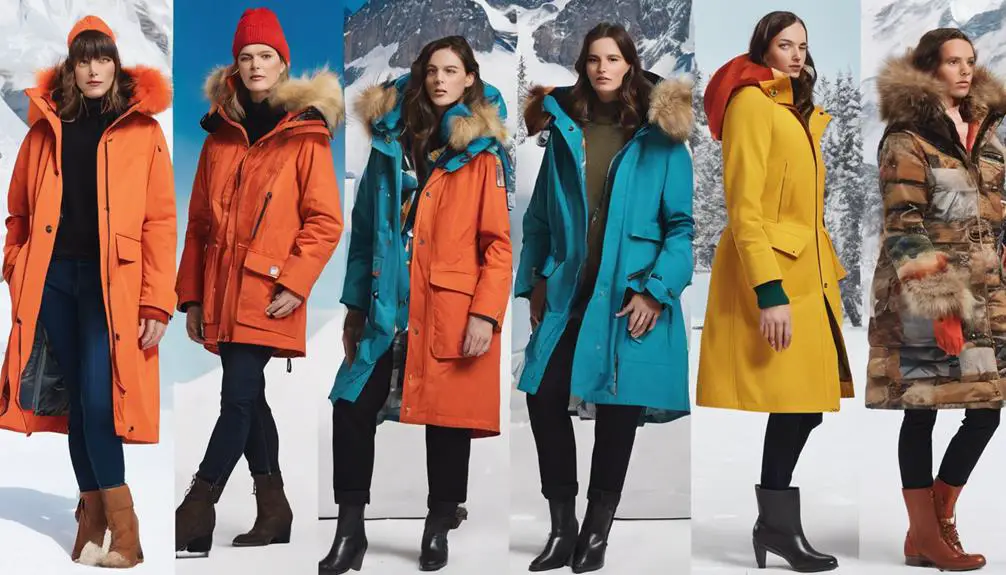
Modern parkas have transformed considerably, evolving from their traditional roots into versatile, stylish outerwear that meets contemporary needs. Gone are the days of heavy animal skins; today's modern parkas often feature synthetic materials that enhance performance and versatility for all-season wear. You'll notice key characteristics like longer cuts for added warmth and oversized fits designed for layering, guaranteeing you stay cozy even in the harshest weather. Additionally, many parkas now incorporate features that allow for easy tailoring and personalization, making them even more appealing to fashion-forward individuals looking for unique fits and styles. Assessing your jacket fit is an essential step to confirm your parka meets your comfort requirements.
Innovations play a major role in this evolution. Technologies like Gore-Tex have been integrated into modern designs, greatly improving water resistance while maintaining breathability. This means you can brave the elements without feeling stifled, making these parkas ideal for both outdoor adventures and urban life. Plus, many current parkas focus on lightweight designs with advanced insulation, so you can enjoy comfort without the bulk.
Brands such as Moorer and Ermenegildo Zegna have embraced this shift, offering high-end parkas that blend luxury with functionality. This fusion of style and practicality reflects a growing trend toward fashionable outerwear, allowing you to express your unique style while staying warm and dry. With an emphasis on versatility, modern parkas cater to diverse lifestyles, from outdoor enthusiasts to urban dwellers seeking chic options.
In essence, the evolution of modern parkas showcases a remarkable transformation, prioritizing both performance and aesthetics, making them a must-have addition to your wardrobe. Whether you're maneuvering through the city streets or hitting the trails, there's a perfect parka waiting for you!
Contemporary Fashion Trends
Contemporary fashion trends have embraced the parka as a staple piece, seamlessly blending utility with style. You'll find contemporary parkas come in a variety of stylish designs, making them perfect for any occasion. Whether you prefer down and synthetic options, there's a parka that suits your needs, ensuring you stay warm without sacrificing fashion. High-end fashion brands like Moorer and Ermenegildo Zegna have elevated the parka into luxurious outerwear, ideal for urban wear, showcasing how protective gear can also be chic.
One of the exciting aspects of modern parkas is their functionality. Innovations in insulation materials, such as Gore-Tex, provide incredible warmth and mobility, allowing you to wear them in various seasons. This versatility means you can easily layer them over tailored outfits or incorporate them into your outdoor adventure gear.
Moreover, the influence of heritage-focused brands, like Nigel Cabourn, has reignited interest in military-inspired designs, adding an element of timeless style to contemporary fashion. These designs not only pay homage to the past but also resonate with today's fashion trends, appealing to diverse demographics.
Material Innovations and Sustainability
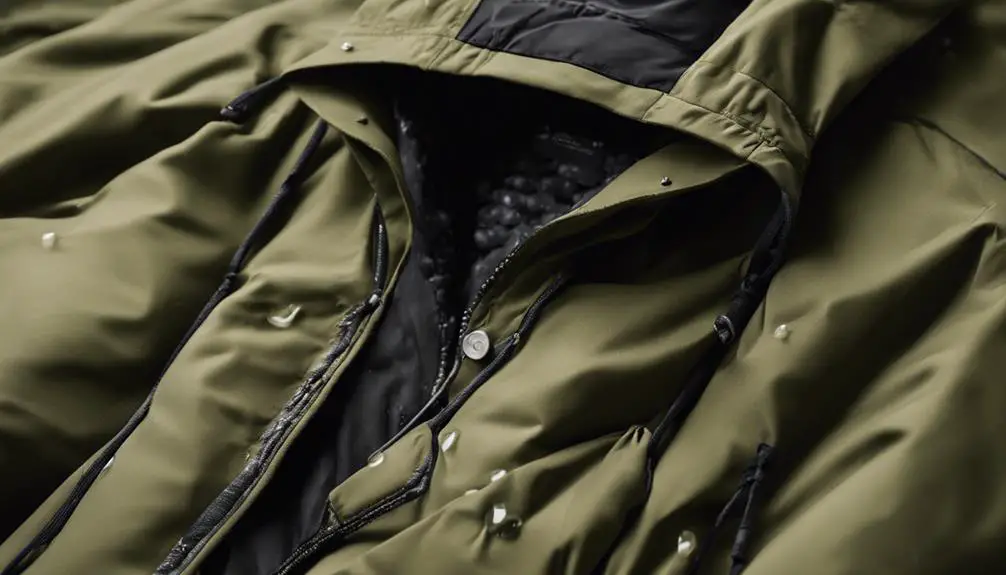
There's no denying that material innovations have revolutionized the parka, making it a go-to choice for anyone seeking warmth and style. Modern parkas have evolved dramatically, shifting from traditional animal skins to lightweight synthetic materials that cater to all-season wear. This transformation enhances performance and comfort, allowing you to stay cozy without feeling weighed down. Insulation technology has also taken a leap forward, with contemporary designs using advanced down and synthetic fibers that maximize warmth while minimizing bulkiness.
Weather-resistant fabrics like Gore-Tex have become staples in parka manufacturing, providing excellent protection against the elements without sacrificing breathability. Whether you're braving the wind or facing rain, these materials guarantee you stay dry and comfortable. As sustainability becomes more important, brands are increasingly incorporating recycled materials and eco-friendly production processes into their offerings. This focus on sustainability not only helps the planet but also appeals to consumers who want to make responsible choices.
The demand for versatile parkas that blend functionality with style has sparked exciting collaborations between heritage brands and modern fashion designers. These partnerships not only promote innovation but also highlight the importance of sustainable practices in the outerwear industry. Today's parkas don't just keep you warm; they represent a commitment to stylish, responsible living. With the right parka, you're not just making a fashion statement; you're embracing a movement towards better materials and a more sustainable future.
The Parka's Legacy in Fashion
The evolution of the parka from functional outerwear to a fashion icon highlights its enduring appeal and adaptability. Originally crafted as military surplus gear, the parka found its footing in the 1960s, thanks to the British mod subculture. Young trendsetters embraced this cold-weather coat, customizing it with vibrant patches and badges, turning it into a must-have fashion item. The iconic fishtail parka, initially designed for military use, further influenced civilian fashion and became synonymous with youth movements, showcasing an effortless blend of functionality and style.
Fast forward to the 1990s, and the parka saw a resurgence, particularly within the Britpop scene. Musicians like Liam Gallagher from Oasis donned the parka, elevating its status in popular culture. Designers recognized its potential, incorporating contemporary aesthetics into classic styles. Brands like Gloverall introduced modern takes on the parka, featuring vibrant contrast linings and refined details, appealing to a new generation of fashion enthusiasts.
Today, the parka's legacy endures as modern fashion brands continue to innovate, using advanced insulation technologies and materials that cater to both functionality and contemporary style preferences. Whether you're looking for a stylish way to stay warm or a nod to the past, the parka remains a versatile staple in your wardrobe. Its rich history and constant evolution guarantee that it will always be more than just a coat; it's a statement piece that connects generations of fashion lovers.
Frequently Asked Questions
What Culture Wears a Parka?
You'll find parkas worn across cultures, especially reflecting Inuit heritage for Arctic survival. Their fashion evolution showcases modern adaptations, with cultural significance in layering techniques and indigenous designs, influencing global trends and ceremonial uses today.
What Is the History of the German Parka?
You'll find the German parka's history fascinating, blending military practicality with fashion evolution. From Arctic expeditions to modern designs, it reflects cultural significance, material innovations, and celebrity influences, adapting through regional variations and outdoor activities.
What Is the Purpose of a Parka?
A parka's purpose is to keep you warm and dry in cold climates. Its insulation properties, waterproof materials, and design variations make it ideal for outdoor activities, layering techniques, and seasonal fashion while reflecting historical significance and cultural symbolism.
What Is a Traditional Parka?
A traditional parka combines insulation technology with design variations, often using traditional materials like fur. You'll find functional pockets, stylish options, and diverse color choices that reflect both weather resistance and cultural significance in modern adaptations.
